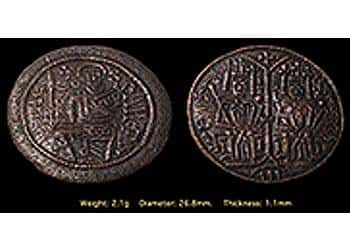Béla III - the Byzantine King!
02/21/16
 <p><strong>On my first day out with my new X-TERRA 705 I found this thin copper coin in an old field on the outskirts of a small Eastern European hamlet.</strong> I was hunting in an old farm field along a stream, and found nothing for an hour. Then, just as the sun was setting I hit this small, very thin coin. At first I was not sure what it was, because the features that I could see appeared to be Byzantine, not European. However, my friend quickly ID it correctly as a Hungarian Coin.</p>
[split]
<p>The coin is called an "AE (copper) Scyphate Follis" from Hungary’s Arpad dynasty, minted in the late 1100's.</p>
<p>The obverse legend reads + SANCTA-MARIA and shows the Virgin Mary enthroned holding lys scepter in right hand, holding Christ child wrapped in swathing bands in left.</p>
<p>The reverse reads R_EX BELA-R_EX STS and shows king Béla on the left and his deceased brother King Stephan III (1162-1172) , in Byzantine style, both holding scepters in right hand across shoulder and a globus cruciger in left.</p>
<p>King Béla III (c. 1148 – 23 April 1196) was King of Hungary and Croatia. He was educated in the court of the Byzantine Emperor Manuel I, who was planning to ensure his succession in the Byzantine Empire till the birth of his own son. This may explain why the coin takes on a very distinct Byzantine style. King Béla III was one of the most powerful rulers of Hungary and he was also one of the most wealthy monarchs of Europe of his age: his annual revenue was the equivalent of 23 tons of pure silver. This exceeded the income of the French king (estimated at 17 tons) and was double the receipts of the English Crown. He is entombed in Matthias Church, in Budapest.</p>
<p>For medieval history buffs.. here's a lot more detail. This is an excerpt from Stephen Sisa's excellent history of Hungary "The Spirit of Hungary : A Panorama of Hungarian History and Culture".</p>
<p></p>
<p><strong>On my first day out with my new X-TERRA 705 I found this thin copper coin in an old field on the outskirts of a small Eastern European hamlet.</strong> I was hunting in an old farm field along a stream, and found nothing for an hour. Then, just as the sun was setting I hit this small, very thin coin. At first I was not sure what it was, because the features that I could see appeared to be Byzantine, not European. However, my friend quickly ID it correctly as a Hungarian Coin.</p>
[split]
<p>The coin is called an "AE (copper) Scyphate Follis" from Hungary’s Arpad dynasty, minted in the late 1100's.</p>
<p>The obverse legend reads + SANCTA-MARIA and shows the Virgin Mary enthroned holding lys scepter in right hand, holding Christ child wrapped in swathing bands in left.</p>
<p>The reverse reads R_EX BELA-R_EX STS and shows king Béla on the left and his deceased brother King Stephan III (1162-1172) , in Byzantine style, both holding scepters in right hand across shoulder and a globus cruciger in left.</p>
<p>King Béla III (c. 1148 – 23 April 1196) was King of Hungary and Croatia. He was educated in the court of the Byzantine Emperor Manuel I, who was planning to ensure his succession in the Byzantine Empire till the birth of his own son. This may explain why the coin takes on a very distinct Byzantine style. King Béla III was one of the most powerful rulers of Hungary and he was also one of the most wealthy monarchs of Europe of his age: his annual revenue was the equivalent of 23 tons of pure silver. This exceeded the income of the French king (estimated at 17 tons) and was double the receipts of the English Crown. He is entombed in Matthias Church, in Budapest.</p>
<p>For medieval history buffs.. here's a lot more detail. This is an excerpt from Stephen Sisa's excellent history of Hungary "The Spirit of Hungary : A Panorama of Hungarian History and Culture".</p>
<p></p>

